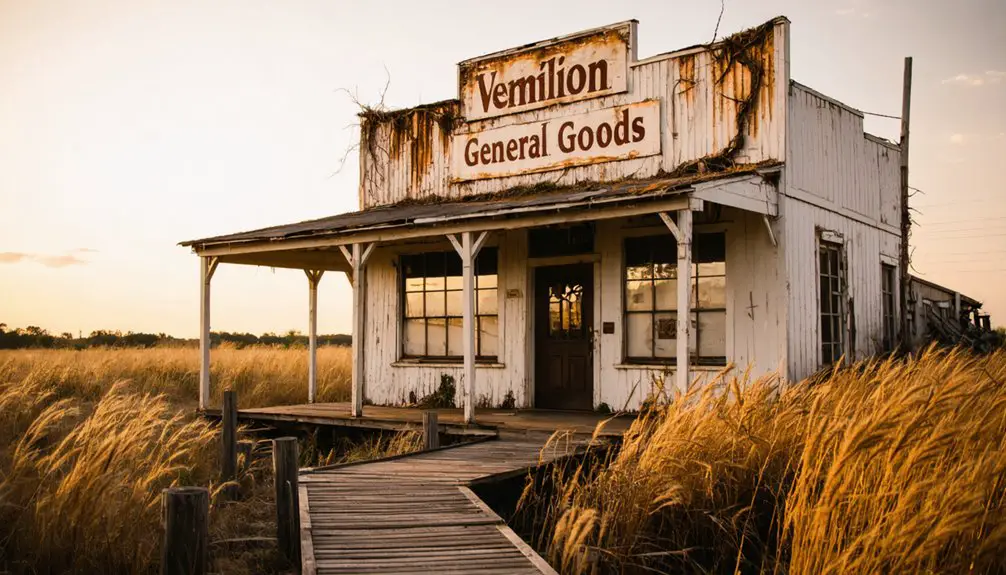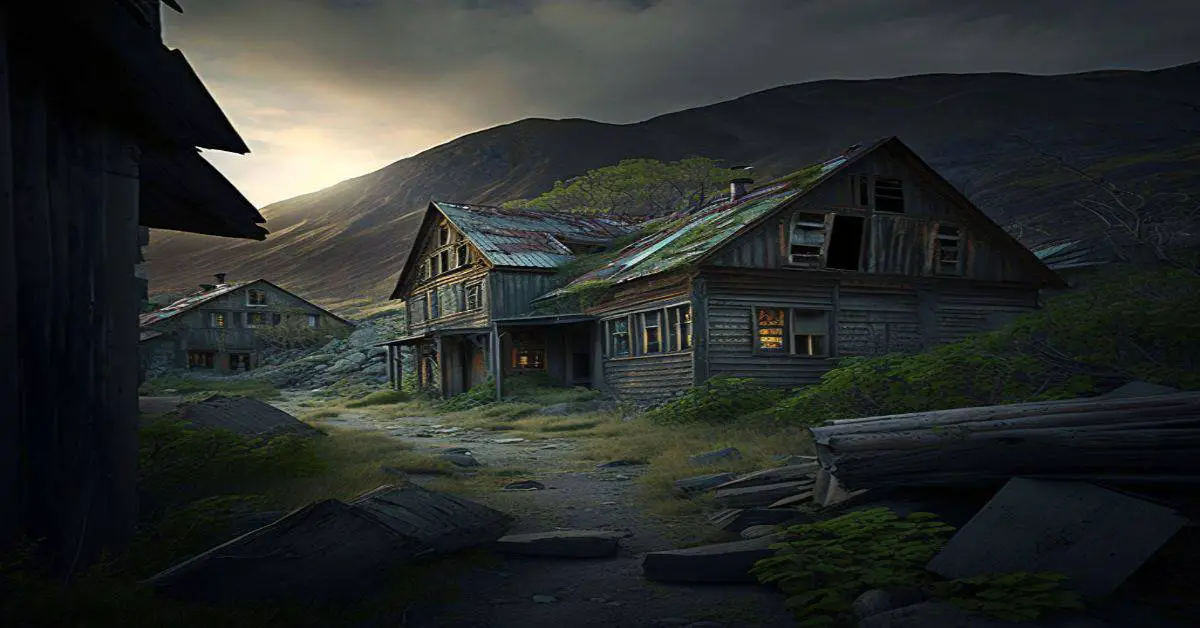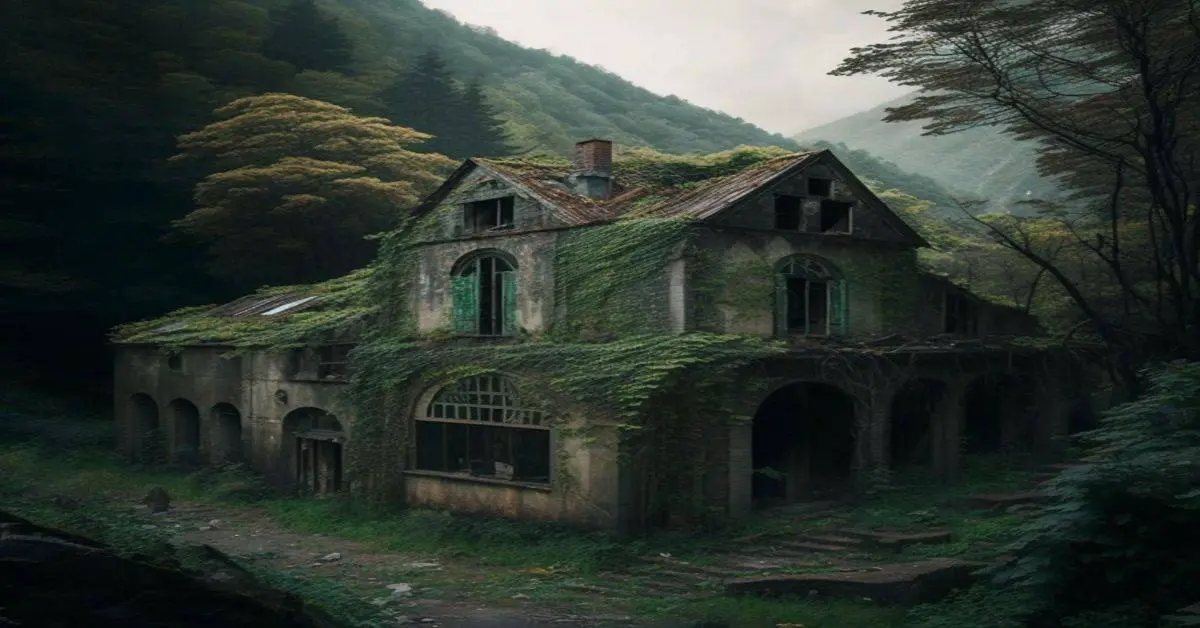You’ll find Vermilion Point’s abandoned Life-Saving Station along Lake Superior’s “Shipwreck Coast,” where brave surfmen once rescued mariners from 1876 to 1944. The isolated outpost earned the nickname “Alcatraz” due to its harsh conditions and remote location. Today, this ghost town preserves Michigan’s maritime heritage through its historic station – the last surviving example of four original structures. The site’s haunting tales of shipwrecks and phantom rescues echo through time.
Key Takeaways
- Vermilion became a ghost town after its Life-Saving Station closed in 1944, following years of extreme isolation and harsh conditions.
- The abandoned site features the last surviving 1876 Lake Superior Type life-saving station along the “Shipwreck Coast.”
- Harsh winters, limited access, and deteriorating infrastructure contributed to the settlement’s eventual abandonment and ghost town status.
- The site originally served Native American tribes and later became crucial for maritime rescue operations before its desertion.
- Visitors can explore remains of the historic life-saving station and remnants of maritime heritage at this isolated Lake Superior location.
The Origins of Vermilion Point
As maritime traffic surged along Lake Superior’s treacherous southeastern shore in the late 19th century, the U.S. Life-Saving Service established Vermilion Point Life-Saving Station in 1876.
You’ll find this historic outpost positioned strategically along the infamous “Shipwreck Coast,” where countless vessels met their fate in the dangerous waters. The station’s maritime safety legacy began as one of four original stations built to protect sailors braving Lake Superior’s unforgiving conditions.
Constructed in the distinct 1876 Lake Superior Type architectural style, Vermilion Point station stood as a beacon of hope amidst dense forests and challenging terrain. Much like early settlers who used skins and furs as legal tender, the station’s crew relied on local resources to sustain themselves. Over the years, the station expanded with additional structures including a boathouse and watch tower.
The remote location, accessible only by logging trails, demanded self-sufficiency from its crew.
Today, it’s the last surviving station of its kind, preserving an essential chapter in Vermilion history.
Native American Heritage and Early Settlement
As you explore Vermilion Point’s history, you’ll find that Native Americans established important trade routes centered on the area’s distinctive red clay pigments used for ceremonial purposes.
The location served as a significant gathering site where tribes, particularly the Erie and later the Ottawa and Huron peoples, would collect natural resources including wild cranberries from local marshes. Historical records show the Kickapoo tribe maintained seasonal camps in this region during their migrations through Illinois territory.
These early inhabitants left behind numerous artifacts while maintaining seasonal settlements along the lakeshore, creating a rich cultural heritage that predates European arrival. Adrien Jolliet first explored this territory in 1669, marking the beginning of French influence in the region.
Vermilion Pigment Trade Routes
While indigenous peoples had long valued red ochre from local sources, the introduction of vermilion (mercury sulfide) pigment transformed Native American trade networks across the Great Lakes region.
You’ll find evidence of extensive vermilion trade along the intricate waterways connecting Rainy Lake to the Mississippi Headwaters and Lake Superior’s Fond du Lac region.
Ottawa, Huron, and Chippewa peoples established crucial trading relationships through these routes, exchanging vermilion alongside furs and other goods with French traders. The pigment’s distinctive bright red color made it highly sought after by European merchants throughout the eighteenth century.
The pigment’s spiritual significance enhanced its value in Native exchanges, where it served both as currency and sacred material.
Through portages and river systems like the Vermilion-Pike-St. Louis corridor, indigenous traders maintained complex economic networks that shaped alliances and cultural connections throughout the upper Midwest.
Indigenous Gathering Sites
Linwood Park stands as a symbol of Vermilion’s rich indigenous heritage, marking the location of a principal Native American village that thrived long before European settlement.
You’ll find evidence of indigenous practices through artifacts like arrowheads and tools scattered along riverbanks. The area served as an essential gathering point where seasonal gatherings centered around natural resources. Local tribes established settlements near Sand Creek’s banks, creating a vital water source for their communities. Native peoples made tobacco offerings to honor the sacred cliffs and formations that dotted the landscape.
- Vermilion Point became an important stopover for Native Americans traveling Lake Superior’s south shore, especially for cranberry harvesting in local bogs.
- The region’s unique mineral deposits, including the namesake vermilion pigment, were collected for traditional ceremonies and artwork.
- Natural landmarks held deep spiritual significance, influencing travel routes and settlement patterns of tribes like the Ottawas, Hurons, and Chippewas until the 1800s.
Early Cranberry Harvest Traditions
During the peak autumn season, Indigenous peoples from across Michigan’s Upper Peninsula converged on Vermilion’s cranberry-rich bogs for their annual harvest traditions.
You’d find them wading through marshes or paddling canoes, using wooden scoops to gather the ripe berries while practicing time-honored cranberry rituals that included ceremonial singing and fire-setting.
These harvest techniques weren’t just about gathering food – they were integral to community life. The Indigenous people skillfully used canoes for preserving venison with cranberries for the winter months ahead.
As you collected berries, you’d join in festivities that could last up to a week during Cranberry Day celebrations.
After harvest, you’d dry the berries in the sun on thatched scaffolds, prepare them with maple sugar, or combine them with dried meat to make pemmican.
The berries also served practical purposes as natural dyes and medicinal treatments, with their juice providing deep red dye for traditional rugs and clothing.
Rise of the Life-Saving Station
You’ll find the most treacherous section of Lake Superior at Vermilion, where deadly shipwrecks in the “Graveyard of the Great Lakes” prompted the establishment of a life-saving station in 1876.
The station’s brave surfmen endured harsh isolation while maintaining constant readiness through rigorous training in specialized rescue boats designed for severe conditions. Today, dedicated restoration teams are installing period appropriate windows to maintain the station’s historical authenticity.
Your understanding of their heroic legacy deepens when you learn these surfmen earned such renown for their skills that they were selected to demonstrate life-saving techniques at the 1904 St. Louis World Fair.
Treacherous Waters Demand Action
Following the opening of the Soo Locks in 1855, southeastern Lake Superior’s waters claimed so many vessels that mariners began calling it the “Shipwreck Coast” and “Graveyard of the Great Lakes.”
The surge in maritime traffic, combined with the region’s notoriously violent storms and treacherous waters, led the U.S. Life-Saving Service to establish four critical stations in 1876, including Vermilion.
You’ll find that shipping regulations and maritime safety measures became paramount as crews faced nature’s fury:
- Self-bailing, self-righting lifeboats required exceptional skill to navigate through boiling seas
- Lifesavers trained rigorously to combat life-threatening storms and shipwreck emergencies
- The station’s isolated location demanded constant readiness, with supplies often arriving by boat or dog sled in harsh winters
The Vermilion station’s strategic position proved essential for protecting maritime commerce along this deadly stretch of coastline.
Heroes Train and Prepare
The Vermilion Life-Saving Station emerged in 1877 as a tribute to the U.S. Life-Saving Service‘s commitment to protecting mariners on Lake Superior’s treacherous “Shipwreck Coast.”
You’ll find the station earned its nickname “Alcatraz” due to its extreme isolation, where winter supplies often arrived by dog sled in the 1930s.
The station’s surfmen training was nationally renowned. These brave heroes conducted intense rescue drills in self-bailing lifeboats, mastering their craft in turbulent waters.
Their exceptional skills earned them a spotlight at the 1904 St. Louis World Fair, where they demonstrated advanced seamanship.
Life at the station meant constant readiness – monotonous days of practice could transform instantly into dramatic rescue operations, requiring peak physical condition and unwavering courage in Lake Superior’s most dangerous waters.
Daily Life at the “Alcatraz” of Lake Superior
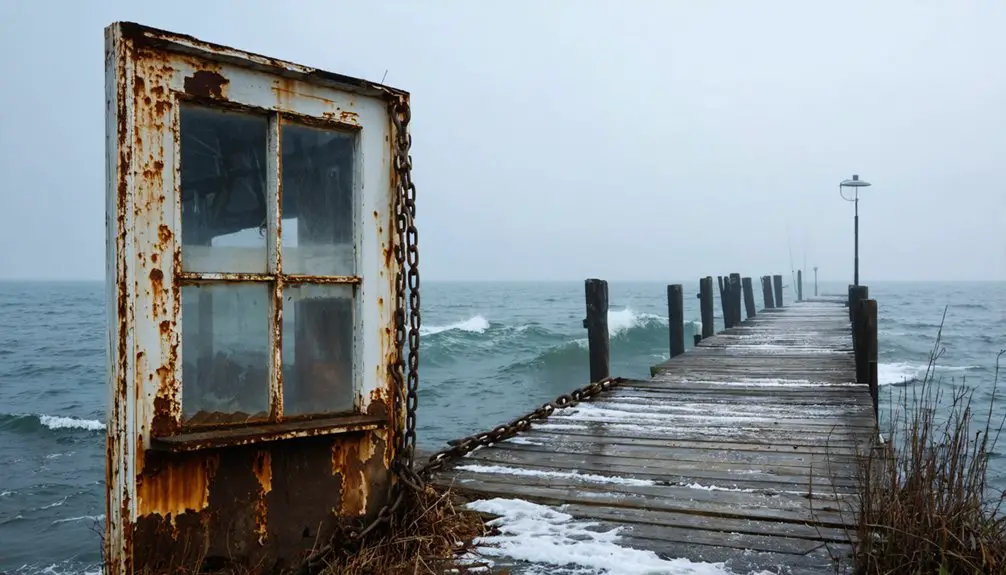
Life at Vermilion’s remote lifesaving station earned its nickname as the “Alcatraz” of Lake Superior through its unforgiving isolation and harsh conditions. The isolation impacts were felt deeply by surfmen and their families, who endured long stretches of monotony punctuated only by intense rescue operations.
Isolated on Lake Superior’s shores, Vermilion station’s hardened crews faced endless solitude broken only by desperate rescue missions.
You’d find yourself surrounded by dense forests, bogs, and marshes, with winter’s grip making supply deliveries nearly impossible – sometimes arriving only by dog sled.
Your daily duties involved rigorous training with self-bailing lifeboats in rough waters.
You’d maintain constant vigilance through rotating shifts, ready to respond to maritime emergencies.
Your family would adapt to modest accommodations with limited social interaction.
Even radio and radar came too late to ease the burden, as the station merged into the Coast Guard by 1915, ultimately closing its doors in 1944.
Shipwrecks and Maritime Rescues
You’ll find the haunting remains of these maritime disasters scattered across the lake bottom.
The *Miztec*, a three-masted schooner lost in 1921 with all hands, lies broken in shallow waters where divers report ghostly encounters.
The *Vienna’s* wreck rests 145 feet deep, while the *Drake’s* remnants, discovered in 1978, have spawned tales of phantom rescue attempts still echoing through the mists of Whitefish Point.
Environmental Challenges and Geographic Isolation
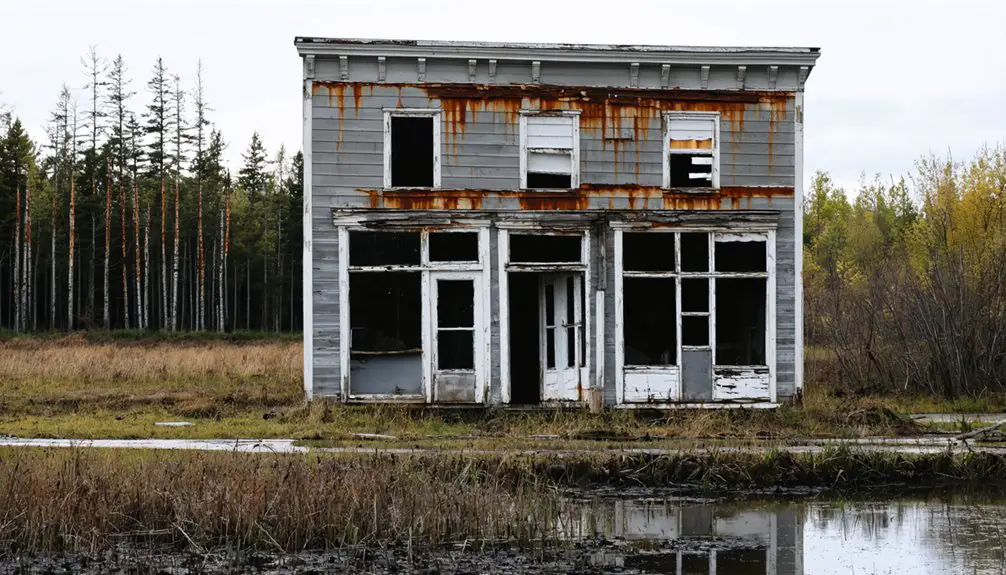
Despite its scenic location along Lake Superior’s shores, Vermilion’s harsh environmental realities and extreme isolation contributed greatly to its eventual abandonment. The environmental impact of past industrial activities, including mining and ore processing, permanently altered the landscape.
You’ll find extensive wetlands and marshes that once supported Michigan’s largest cranberry farm, but these same features complicate construction and limit development options. The isolation challenges are particularly severe during the long winters, when snow cover can last into June, and limited road access restricts the movement of supplies and people.
- The 175-acre nature preserve now protects the historic life-saving station while limiting new development
- Gray skies and minimal sunlight during winter months create challenging living conditions
- Deteriorating infrastructure and sparse population increase the settlement’s isolation from essential services
The Decline of Maritime Operations
As the Great Lakes maritime industry transformed in the early 20th century, Vermilion’s once-bustling shipping operations began their steady decline.
You’ll find that the region’s fleet, which once boasted over 500 vessels, dwindled to roughly 200 by mid-century. Maritime economics drove the shift toward larger, more efficient ships, while stricter shipping regulations reshaped operational practices.
The area’s hazardous conditions, particularly near Vermilion Point, had already claimed numerous vessels in the 1800s, including the Michigan and Dot.
Treacherous waters around Vermilion Point became a graveyard for ships, with vessels like Michigan and Dot succumbing to its dangers.
While technological advances improved navigation safety, changing trade patterns and competition from railroads and highways further diminished the port’s significance.
Today, Vermilion’s maritime heritage lives on primarily through preserved artifacts and historical records, as its commercial shipping activity has fundamentally ceased.
Preserving a Great Lakes Legacy
The preservation of Vermilion’s rich maritime heritage stands as a proof of the region’s historical significance on the Great Lakes.
You’ll find maritime preservation efforts focused on the Vermilion Lifesaving Station, the only surviving station with original structures among its four regional counterparts.
The site’s cultural stewardship extends to underwater heritage, where well-preserved shipwrecks tell stories of 19th and early 20th-century commerce.
- Experience the station’s history through museum exhibits highlighting brave surfmen and their rescue techniques
- Explore the legacy of “Shipwreck Coast,” named after numerous vessels lost following the 1855 opening of the Soo Locks
- Discover how harsh conditions shaped life at the station, from dog sled mail delivery to advanced maritime rescue operations
Exploring the Abandoned Settlement Today
Standing silent along Lake Superior’s rugged shoreline, Vermilion’s ghost town invites explorers to discover its weathered remnants and rich maritime history.
You’ll find original structures from the Life-Saving Station, including a house and service station building, though many others have succumbed to time and vandalism since the station’s 1945 closure.
For your ghost town exploration, follow the hiking trails west of Whitefish Point Lighthouse, winding through cranberry marshes near Vermilion Point.
You’ll experience true nature immersion as you navigate the preserved wilderness, though you won’t find modern visitor facilities.
Since signage is minimal, bring maps or guides to navigate this remote location.
As the last standing settlement among Lake Superior’s shipwreck coast stations, Vermilion offers a unique glimpse into Great Lakes maritime heritage.
Frequently Asked Questions
How Many People Currently Live Within Vermilion’s Original Town Boundaries?
You’ll find no current population within these original boundaries, though the site’s historical significance as a fishing village remains. The area stands empty today, classified as a ghost town.
What Happened to the Original Families After the Life-Saving Station Closed?
You’ll find the original families’ legacies scattered as they relocated following the 1944 closure, with community dispersal leading them to nearby towns like Paradise or other Coast Guard stations along Lake Superior.
Are There Any Dangerous Areas Visitors Should Avoid at the Site?
You’ll want to steer clear of unstable structures and hidden hazards. Take safety precautions around deteriorating buildings, stay away from hazardous areas near shorelines, and avoid overgrown sections with potential mineshafts.
What Items Have Been Found by Archeologists Excavating the Settlement?
You’ll find artifacts discovered include life-saving station equipment, household items from crew families, maritime supplies, and mining specimens. Archaeological excavations have also revealed iron ore samples and station remnants.
Can Visitors Stay Overnight in Any of the Remaining Structures?
You can’t stay overnight in the remaining structures due to historical preservation restrictions and safety concerns. Instead, you’ll need to find overnight accommodations in nearby towns with proper lodging facilities.
References
- https://en.wikipedia.org/wiki/Vermilion_Point
- https://en.wikipedia.org/wiki/Shelldrake
- https://www.youtube.com/watch?v=I84jaSzMFCI
- https://lostinmichigan.net/vermillion-point/
- https://99wfmk.com/vermilion-michigan/
- https://www.discoververmilion.org/visitor-info/history/
- https://uslife-savingservice.org/station/endangered-stations/vermilion-life-saving-station-1876-station-only-paradise-mi/
- https://www.sosvermilion.org/history
- https://www.interlochenpublicradio.org/ipr-news/2025-01-07/maritime-time-vermillion-point
- https://www.discoververmilion.org/news-and-events/news/params/post/4139869/early-history-of-vermilion
